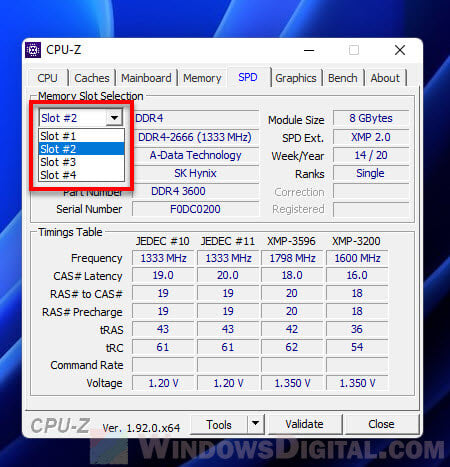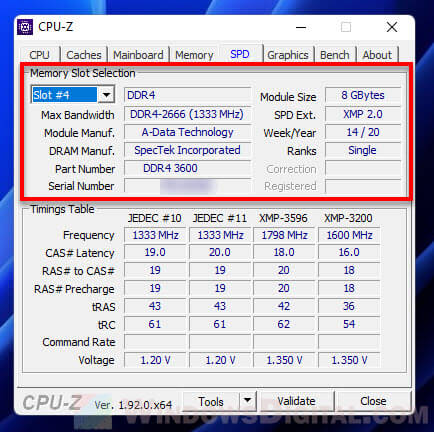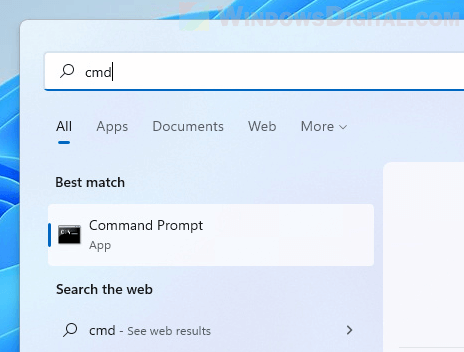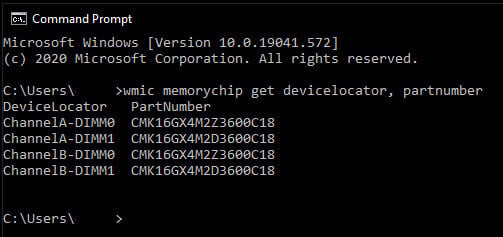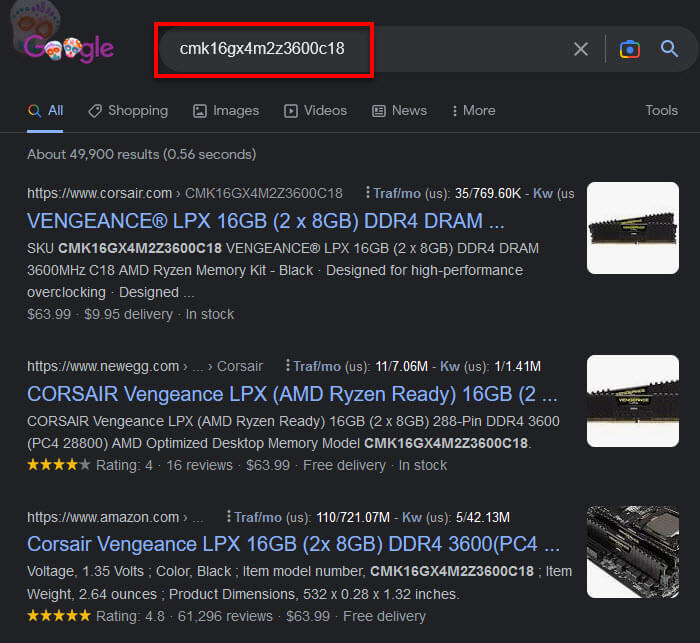Все способы:
- Вариант 1: «Диспетчер задач»
- Вариант 2: Раздел «О системе»
- Вариант 3: Утилита msinfo32
- Вариант 4: «PowerShell»
- Вариант 5: Сторонние программы
- Вариант 6: BIOS
- Вопросы и ответы: 1
Вариант 1: «Диспетчер задач»
Через «Диспетчер задач» в Windows 11 пользователь может не только получить информацию об установленном количестве оперативной памяти, но и узнать, насколько она загружена, как используется файл подкачки, ознакомиться с графиком нагрузки и посмотреть на активные процессы. Этот метод мы считаем приоритетным и самым доступным, поэтому давайте ознакомимся с ним более детально.
- Для начала понадобится перейти в «Диспетчер задач». Для этого щелкните правой кнопкой мыши по кнопке «Пуск» и из контекстного меню выберите соответствующий пункт.
- Перейдите на вкладку «Производительность» и среди мониторов выберите «Память». Кстати, прямо под названием монитора уже видно, сколько памяти из доступной используется.
- Однако вы можете получить более детальные сведения, учитывая количество выделенной памяти, сжатой, кешированной и доступной. Здесь же отображается невыгружаемый пул, большой объем которого иногда становится причиной зависаний в работе ОС.
- Справа вы видите номинальную скорость вашей оперативной памяти, количество занятых слотов, форм-фактор ОЗУ и объем аппаратно зарезервированной RAM.
- Если хотите получить более детальные сведения об использовании оперативной памяти в Виндовс 11, щелкните по ссылке «Открыть монитор ресурсов» внизу.
- Далее перейдите на вкладку «Память» и ознакомьтесь с линией, где наглядно при помощи цветов показано, сколько используется памяти, сколько свободно и сколько находится в ожидании.
- Есть и список процессов, которые можно сортировать как по алфавиту, так и по количеству используемой ОЗУ.
- Если вас интересуют графики использования в режиме реального времени, обратите внимание на три разных справа. Этих сведений вполне достаточно для того, чтобы получить полную картину об ОЗУ в Windows 11.
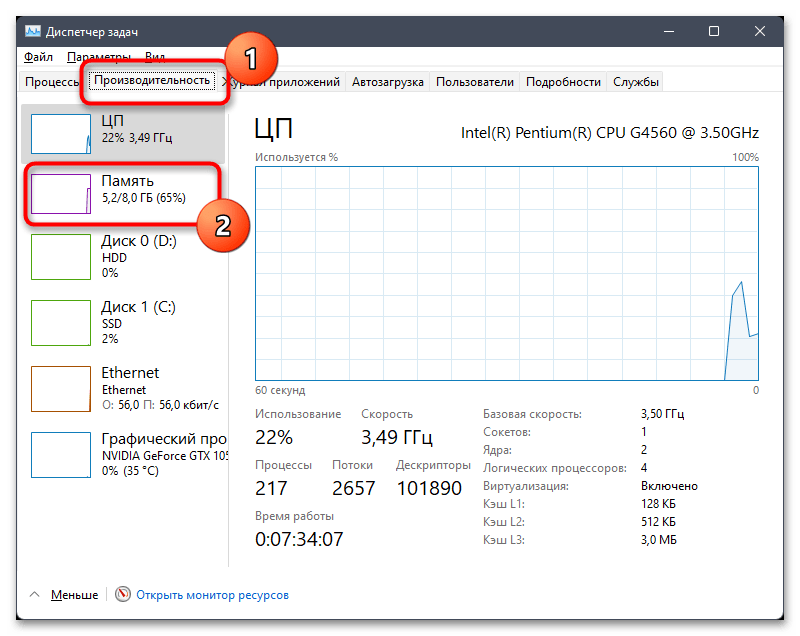
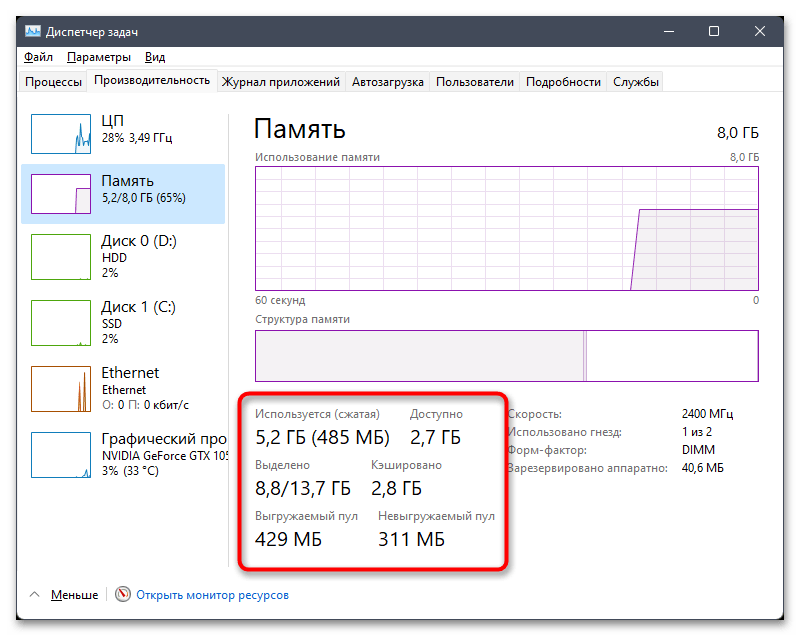
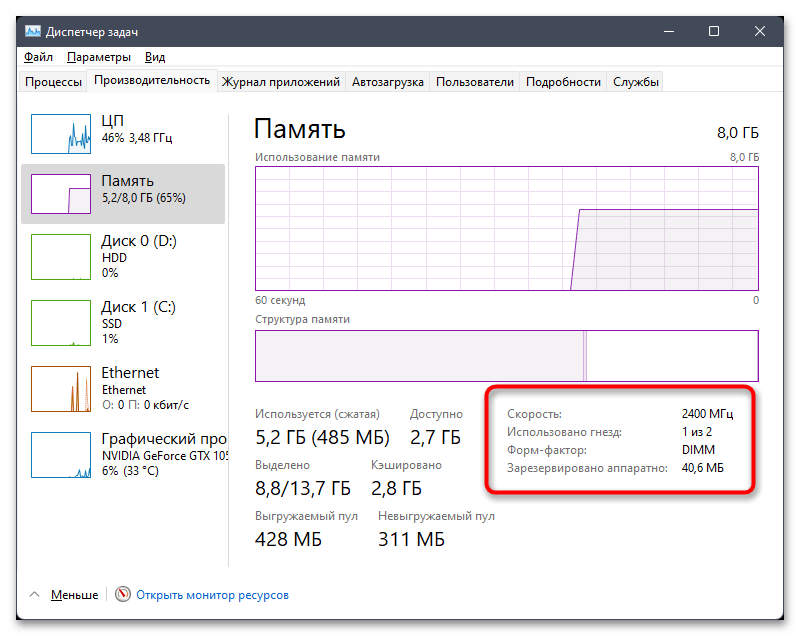
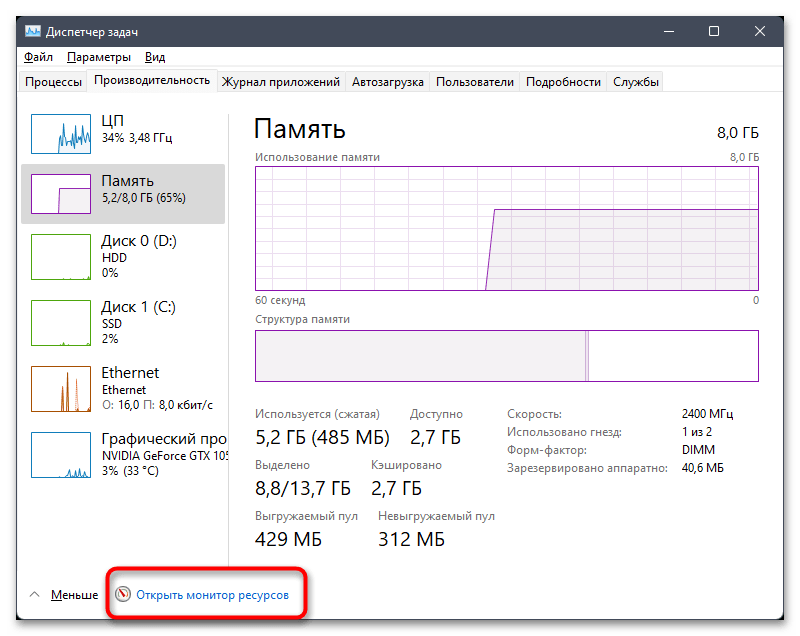
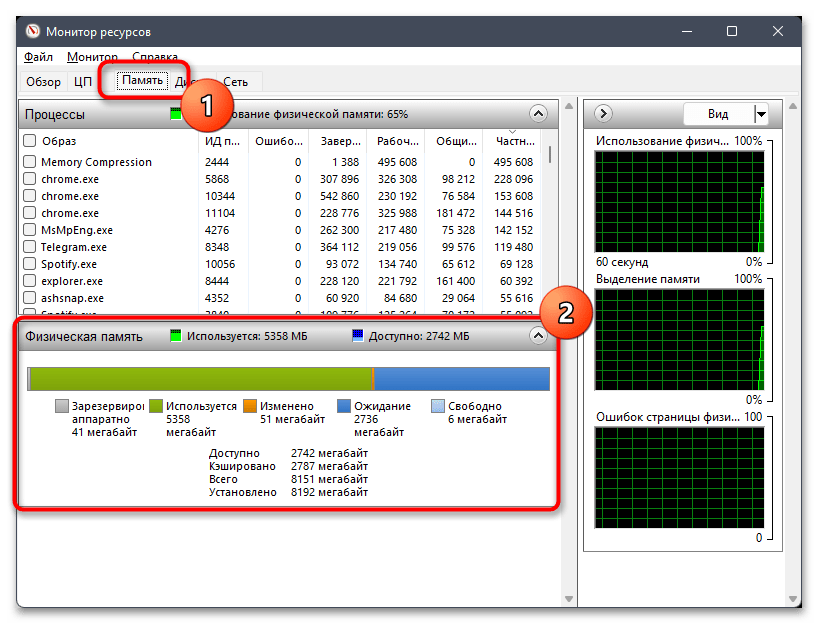
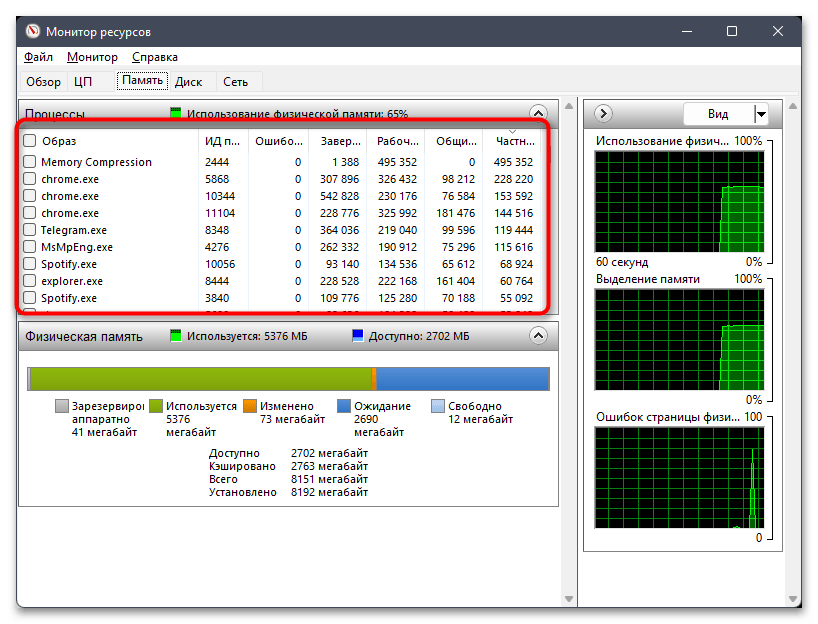
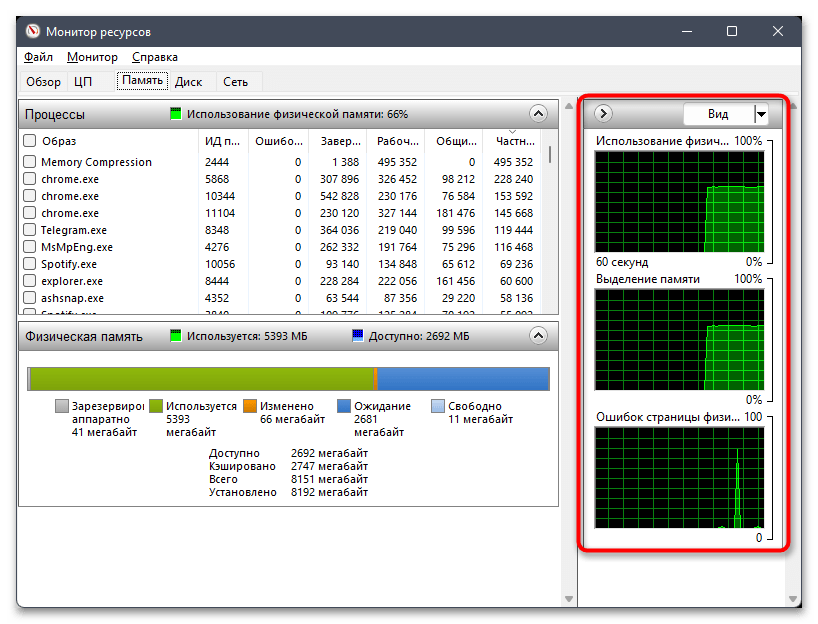
Вариант 2: Раздел «О системе»
Следующий метод более простой и отображает только один параметр оперативной памяти — ее объем. Подойдет тем пользователям, кого только эта характеристика и интересует. Вы можете использовать следующую инструкцию, чтобы понять, как обратиться к требуемому меню и получить нужные сведения.
- Откройте меню «Пуск» и нажмите по закрепленному значку с изображением шестеренки, чтобы перейти в «Параметры».
- На панели слева выберите раздел «Система», прокрутите колесико мыши в самый низ и щелкните по пункту «О системе».
- Теперь остается только найти строку «Оперативная память», чтобы понять, какой номинальный объем ОЗУ установлен в используемом компьютере.
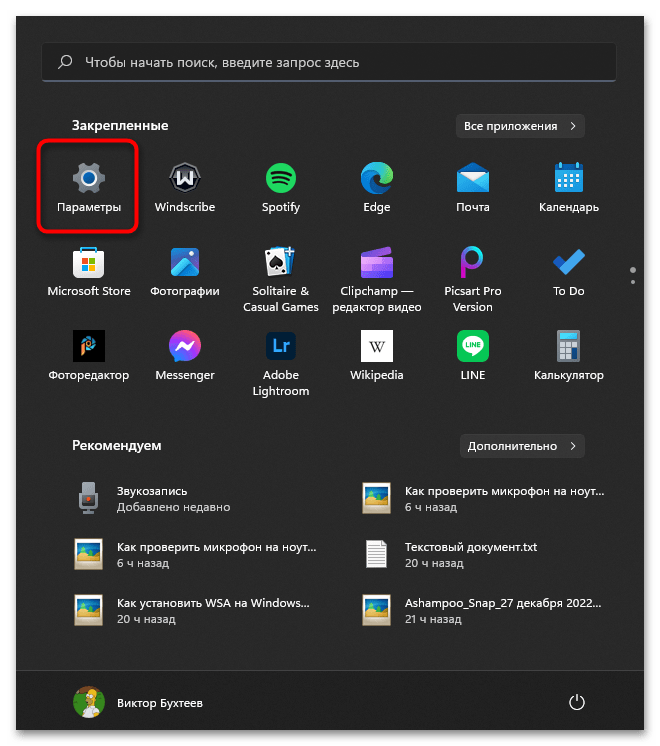
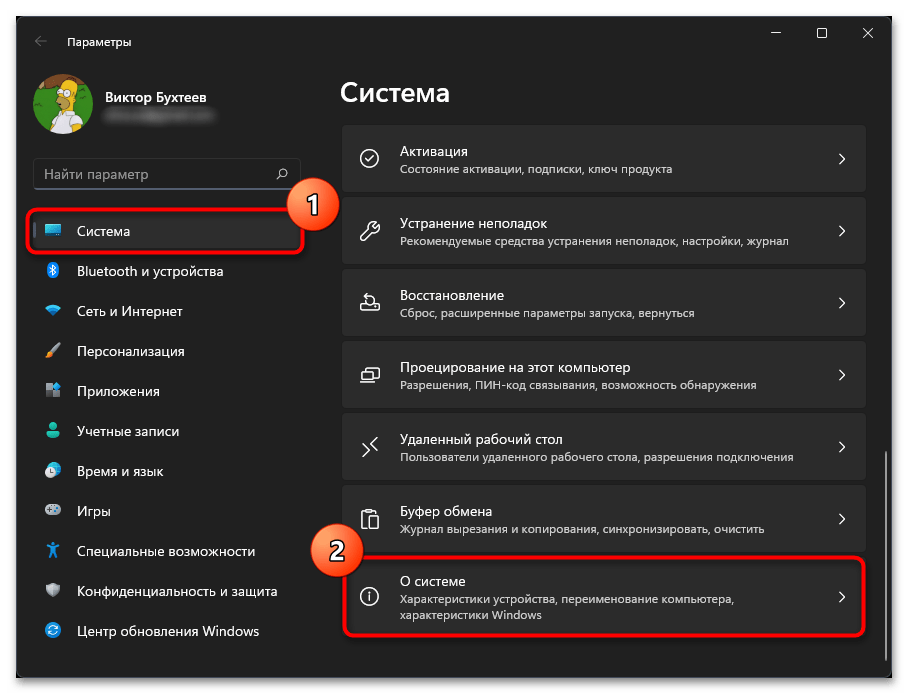
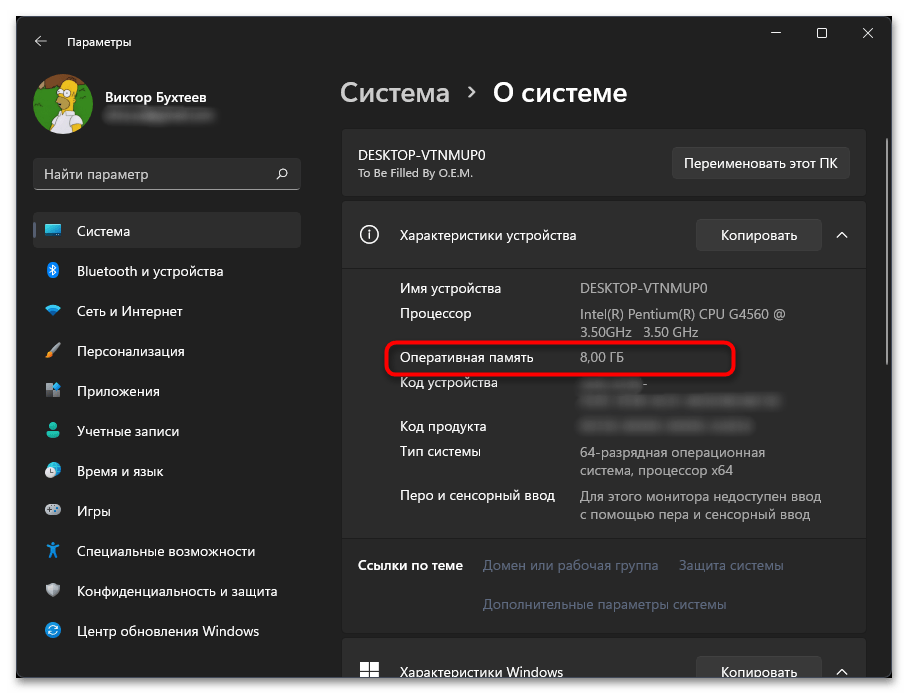
Вариант 3: Утилита msinfo32
Далее предлагаем воспользоваться еще одним стандартным средством Windows 11, при помощи которого можно запросто получить необходимые сведения о характеристиках компьютера, включая данные об оперативной памяти. Строк с информацией будет несколько, поэтому вы даже сможете узнать, сколько установлено виртуальной памяти и какое количество физической доступно в текущий момент.
- Проще всего запустить утилиту через меню «Пуск», для этого в поле ввода укажите
msinfo32и нажмите левой кнопкой мыши по появившемуся соответствию. - В новом окне выберите раздел «Сведения о системе», выделив строку нажатием ЛКМ.
- Прокрутите список с характеристиками немного вниз, чтобы получить информацию об оперативной памяти. Как вы уже поняли, так вы узнаете установленный и доступный объемы ОЗУ, а также количество виртуальной памяти с расположением файла подкачки.
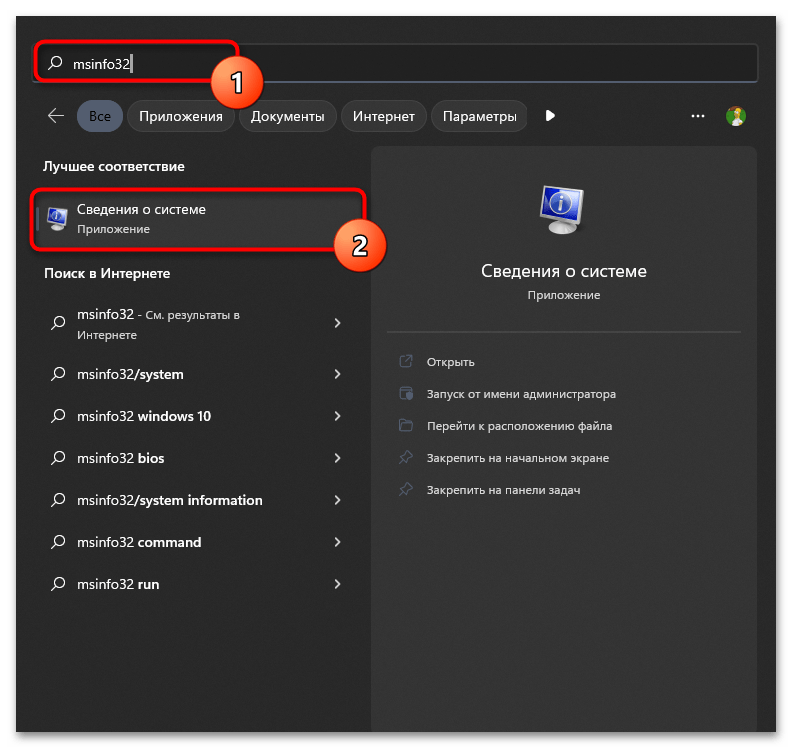
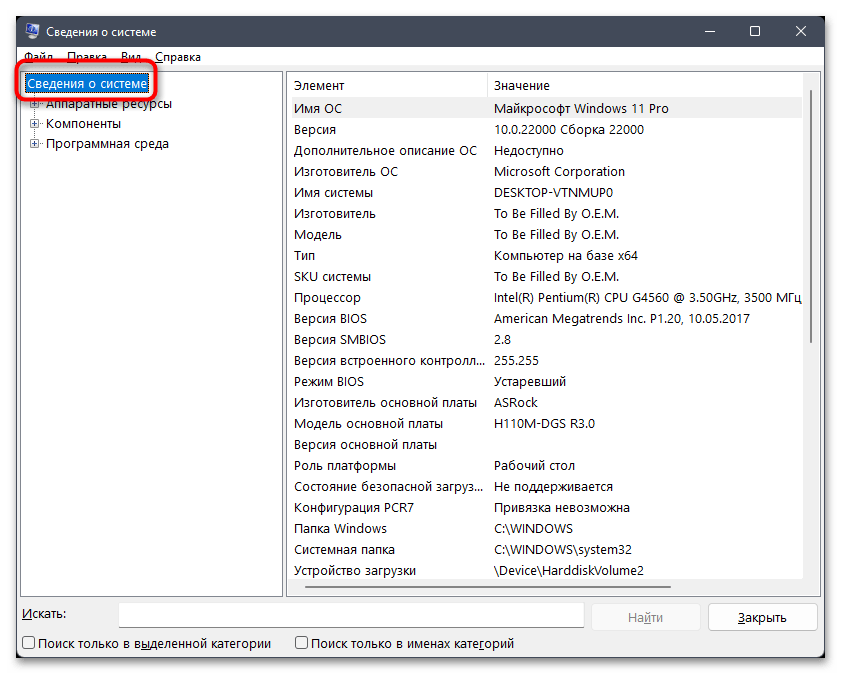
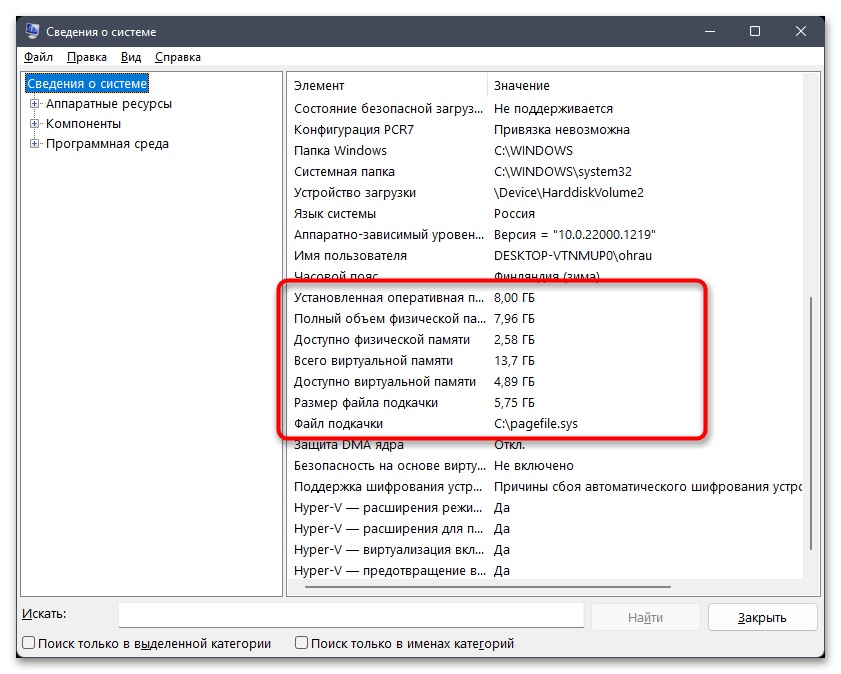
Вариант 4: «PowerShell»
С помощью команды для «PowerShell» можно узнать не только установленный объем оперативной памяти в Windows 11, но и получить информацию об установленной скорости, что тоже бывает актуально. Используемая далее утилита выведет сведения отдельно о каждой плашке, если такие установлены в разных разъемах на материнской плате.
- Щелкните правой кнопкой мыши по «Пуску» и из появившегося контекстного меню выберите пункт «Терминал Windows (Администратор)».
- В появившемся окне «PowerShell» введите команду
wmic MEMORYCHIP get BankLabel,DeviceLocator,Capacity,Speedи нажмите Enter для ее применения. - Первое значение показывает общий объем планки ОЗУ в байтах, поэтому понадобится немного времени на перевод значения в ГБ.
- Далее идет номер слота и информация о канале, что нужно в редких случаях.
- Показатель «Speed» отображает номинальную скорость оперативной памяти, но это не значит, что именно с такой она сейчас работает в операционной системе.
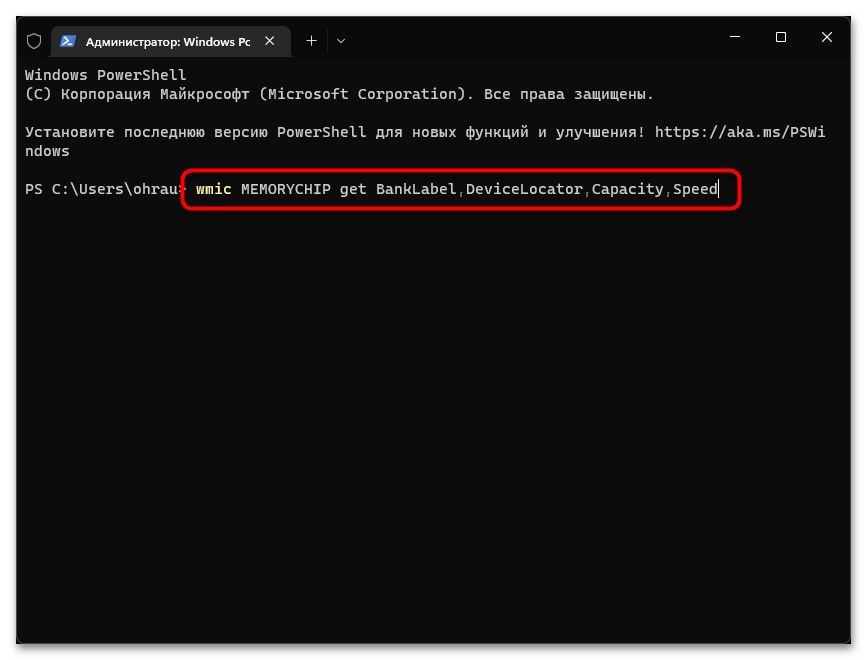

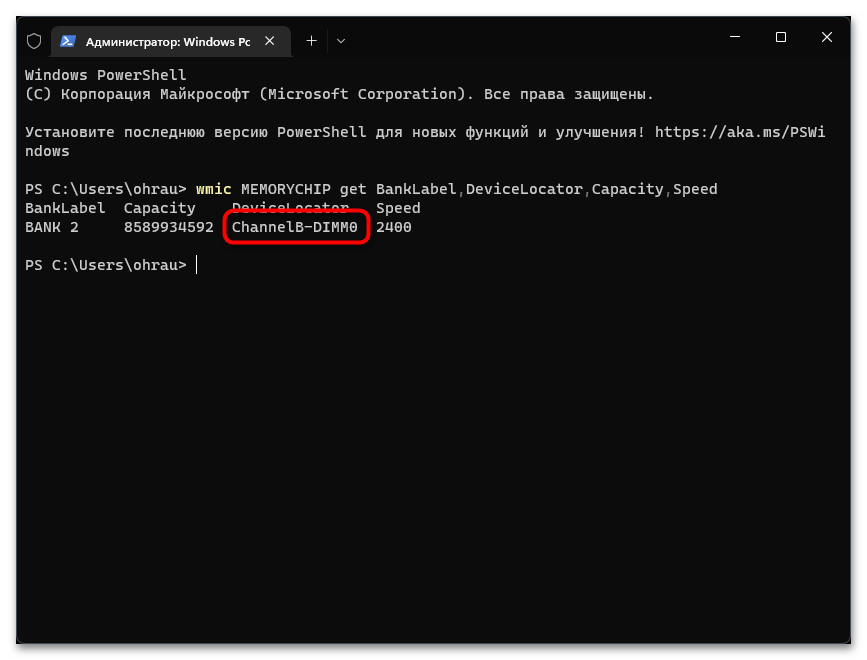
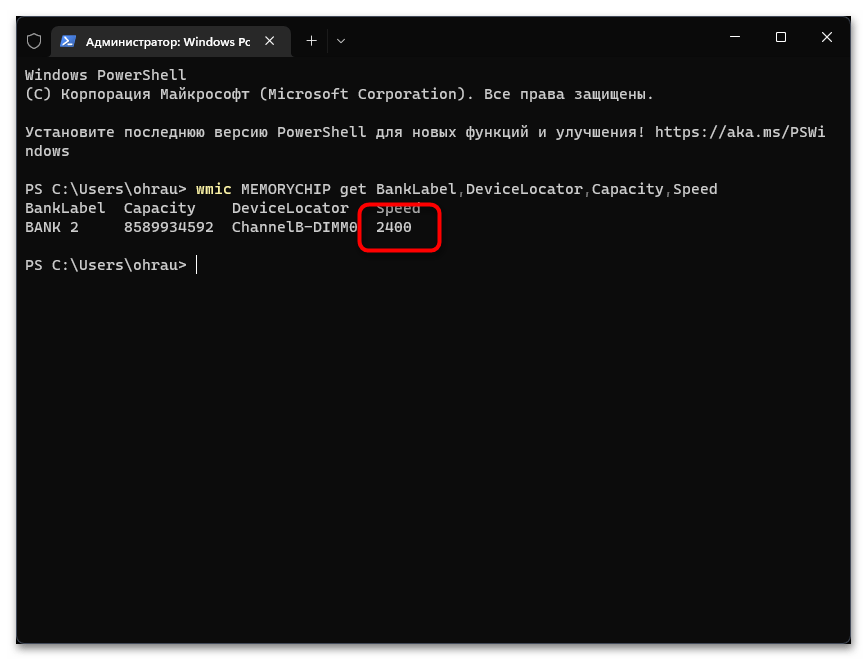
Вариант 5: Сторонние программы
При помощи сторонних программ в Windows 11 можно получить комплексный набор информации о комплектующих и их характеристиках. В рамках данной статьи не будем разбирать всю функциональность подобного рода софта, а только рассмотрим, как осуществляется получение сведений об оперативной памяти на примере бесплатного решения под названием Speccy.
Скачать Speccy
- Вы можете выбрать данную программу или скачать любую другую на свое усмотрение. После установки запустите приложение через значок на рабочем столе или исполняемый файл при поиске через «Пуск».
- В Speccy вы можете выбрать первый раздел с названием «Summary», чтобы получить информацию о том, какой объем оперативной памяти установлен в компьютере, работает ли многоканальность и на какой частоте.
- Если интересуют дополнительные сведения, перейдите в «RAM» и начните ознакомление со всей представленной информацией.
- Здесь же можно увидеть, сколько всего слотов под оперативную память доступно в вашей материнской плате и сколько занято.
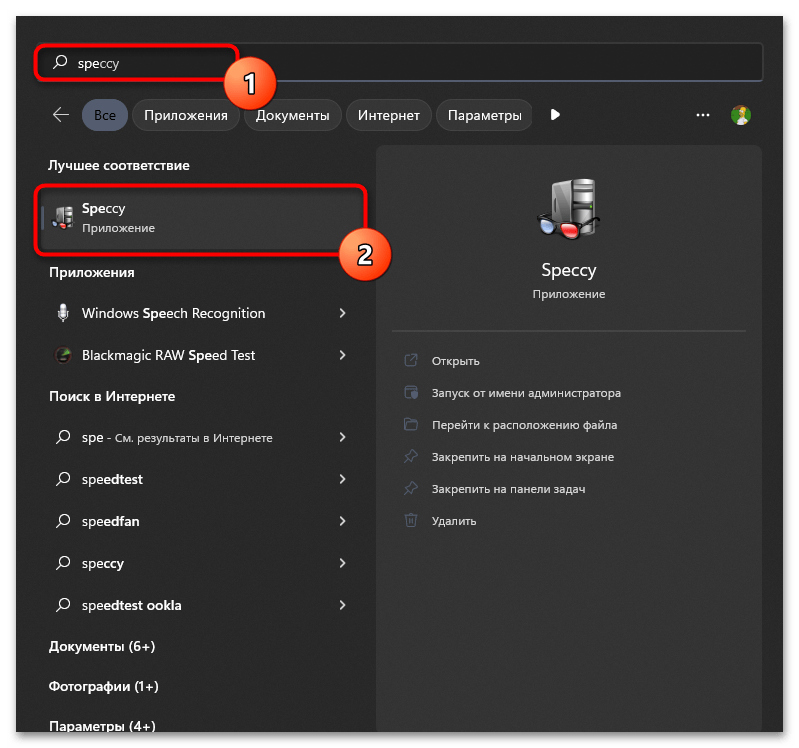
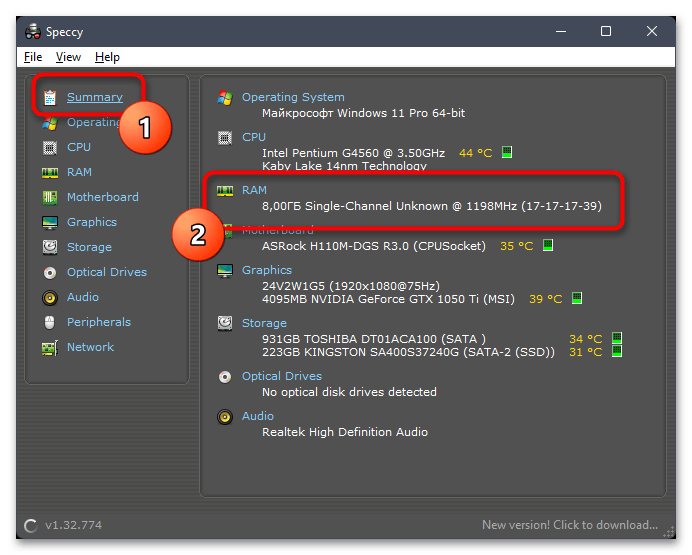
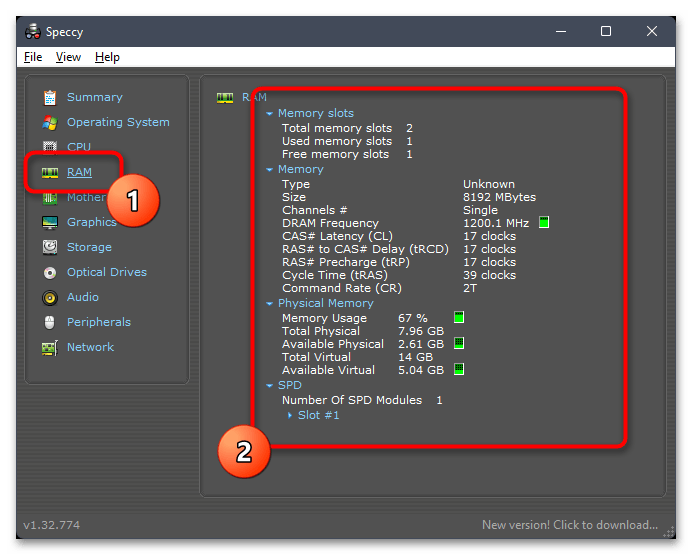
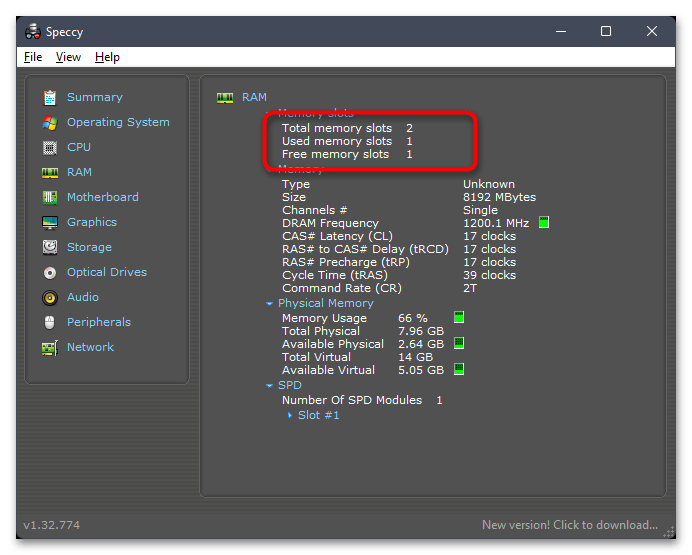
Существуют и другие как платные, так и бесплатные программы, позволяющие юзеру получить сразу всю информацию о характеристиках компьютера. Мы рекомендуем ознакомиться с обзором по следующей ссылке, если вы еще не решили, какой софт использовать в данной ситуации.
Подробнее: Программы для определения железа компьютера
Вариант 6: BIOS
В завершение затронем метод, который непосредственно не связан с Windows 11, поскольку его можно использовать даже без входа в операционную систему. Вам понадобится при загрузке перейти в BIOS и выбрать соответствующий раздел, в котором и показана информация о RAM. Способ перехода к такому разделу и отображающаяся в нем информация зависит исключительно от версии БИОС или UEFI.
Подробнее: Как посмотреть оперативную память в BIOS
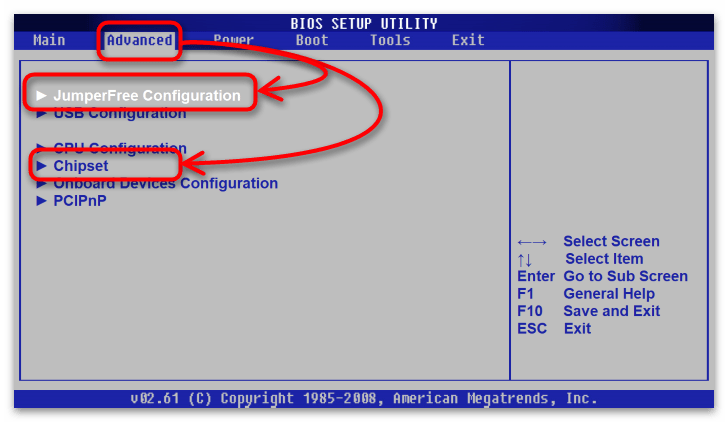
Наша группа в TelegramПолезные советы и помощь
RAM works best together when they are of the same speed (MHz), size, brand and model. If you have multiple RAM sticks with different speeds, all RAM will have to run on the slowest speed among the RAM sticks, which will end up with a slower PC. Thus, it is always recommended to match your RAM sticks.
If you want to add more RAM to your computer, before you purchase any RAM, you should check the existing RAM brand, model and specs first, and then try to buy the same model if possible to match the existing RAM sticks. This ensures your RAM will run at optimal performance.
Also see: How to Check RAM Type DDR3, DDR4 or DDR5 in Windows 11
You may also have other reasons why you would want to check your RAM’s brand and model. If you don’t want to physically remove the RAM sticks just to view their details, this guide will show you several methods on how to check the RAM brand, model and specs in Windows 11 without the need to physically remove them from the motherboard.
Check RAM specifications using CPU-Z
The most convenient method (for those who don’t want to go through any command entering method) to check the RAM brand and model is to use a very popular third party tool called CPU-Z. CPU-Z is a small software that is able to display detailed information about almost all components in your computer, such as CPU, Motherboard, RAM, Graphics, etc.
To check your RAM specs using CPU-Z in Windows 11, follow the steps below.
- Download the CPU-Z tool from the following page. Make sure to download the 64-bit version as Windows 11 has no 32-bit support.
https://www.cpuid.com/softwares/cpu-z.html
- Run the cpuz_x64.exe and select the SPD tab.
- Click the drop-down menu under “Memory Slot Selection” and select the RAM slot you would like to check.
- The details of the RAM stick (mainly Module Manufacturer, Part Number, Module Size, etc.) on the selected memory slot will be displayed.
If you see empty tables, it means there is no RAM stick on the selected memory slot. Try selecting another memory slot. In addition, other advanced details such as RAM Frequency, CAS Latency and Voltage can be viewed in the “Timings Table” section.
Read next: How to Clear RAM Cache in Windows 11
Check RAM brand and model using partnumber
Another useful way to check your RAM brand and model is to first find out its partnumber and then do a Google search using the partnumber. You can quickly find the partnumber of your RAM in Windows 11 using the WMIC command-line utility via Command Prompt. To check the RAM brand, model and specs using the partnumber, follow the steps below.
- Go to the Start menu. Search for and open Command Prompt or “CMD“.
- In the Command Prompt window, type the following command and press Enter (the “devicelocator” parameter tells you which physical slot the RAM module is plugged into).
wmic memorychip get devicelocator, partnumber
- Write down the part number of the RAM you want to check.
- Search the part number on Google and you should be able to see the RAM models with the exact same part number.
Check RAM manufacturer, speed and capacity via CMD
You can also use the WMIC command-line tool in Windows 11 to get more info about your RAM. For example, you can use the command line below to check the RAM manufacturer, speed, capacity and part number.
wmic memorychip get devicelocator, manufacturer, speed, capacity, partnumber
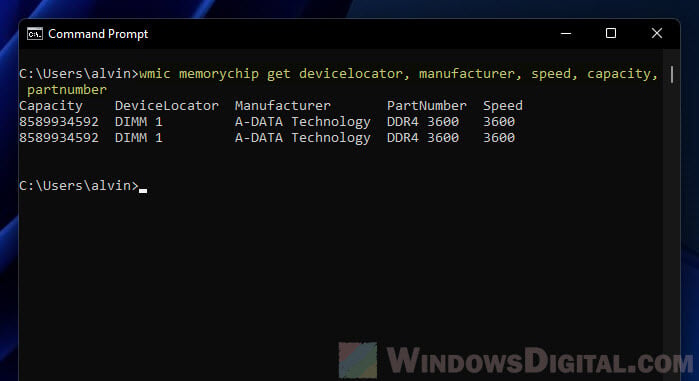
Note that the 3600 speed indicates 3600 MHz. RAM will always be aligned to match the same speed. Thus, the RAM speed you see doesn’t necessary indicate the highest speed capability the RAM can achieve. It just shows you the speed that all modules support, which is the speed of the slowest module, if you have multiple RAM with different speeds. For example, if you have a RAM with 3600 MHz frequency and another with 3200 MHz, both RAM will run at 3200 MHz.
In addition, the capacity shows you the size of the RAM in byte. For instance, my RAM has a capacity of 8589934592 bytes, which is around 8 gigabytes.
You can also use the following command line instead to check the full details about all your RAM sticks via Command Prompt in Windows 11.
wmic memorychip list full
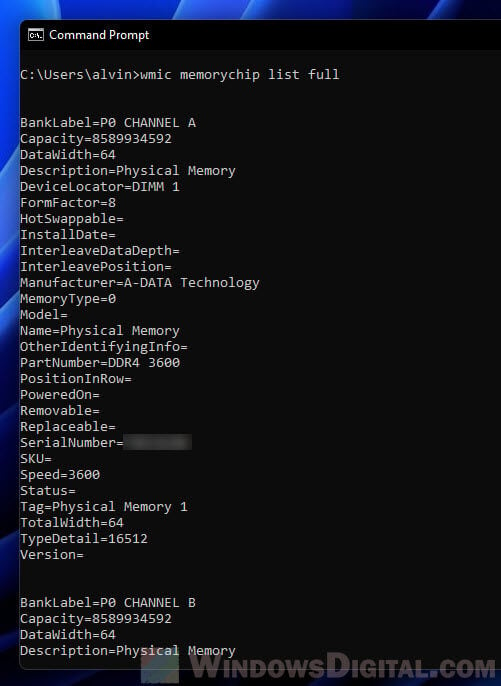
This command line will list all the specifications of all your RAM sticks that the command can retrieve, e.g. the RAM manufacturer, model, part number, speed, capacity, name, and more.
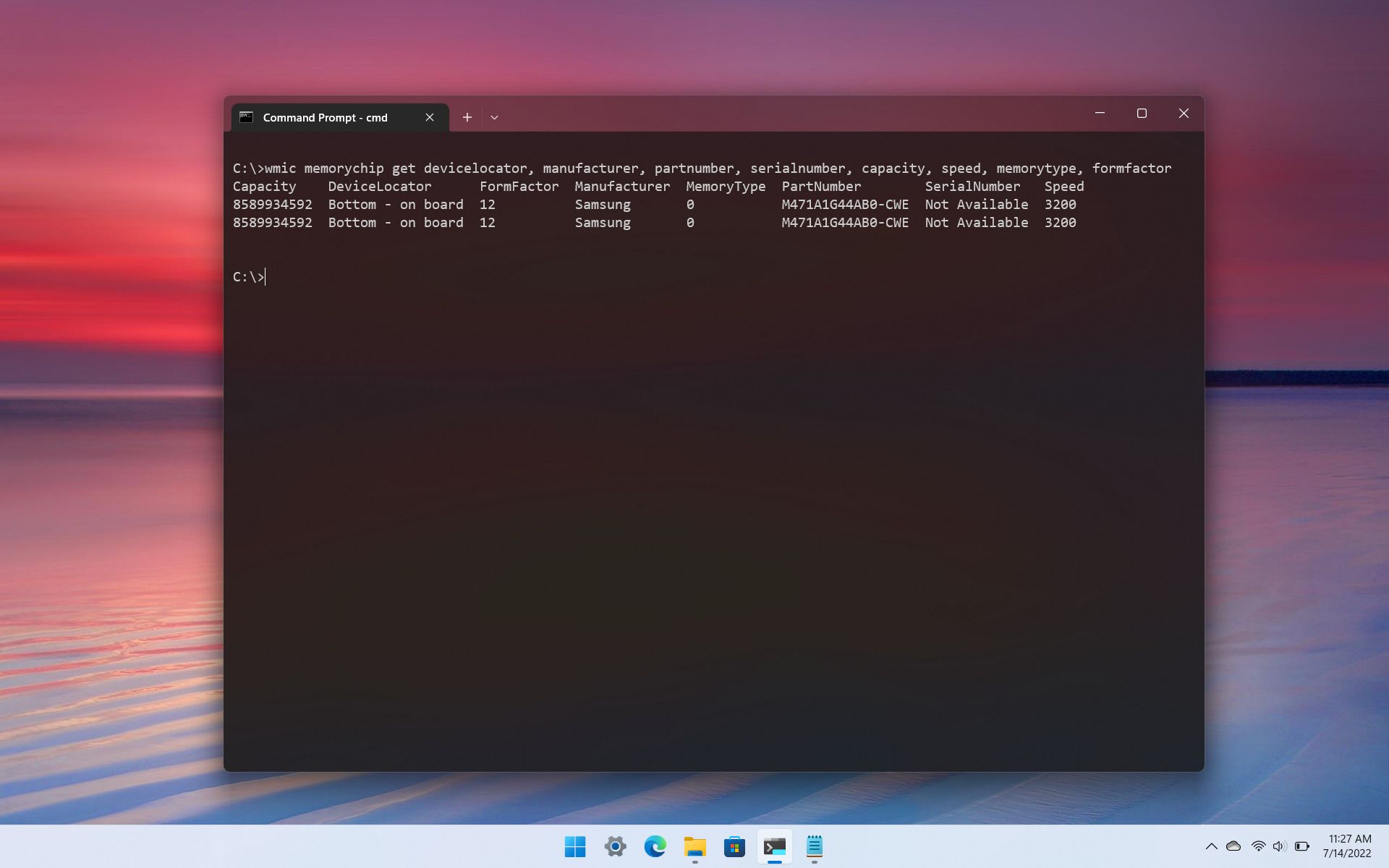
If you have a Windows 11 laptop or desktop computer, understanding the system memory — or RAM (Random Access Memory) — specifications could be helpful to troubleshoot problems with technical support or confirm the changes after tweaking the settings in the Unified Extensible Firmware Interface (UEFI).
Also, if the device is ready for an upgrade, understanding the RAM details can come in handy to determine the brand, speed, size, and other information you may need to get the correct modules to improve system performance.
Whatever the reason, you can use Command Prompt on Windows 11 to quickly find out all the information without using Task Manager or third-party tools.
This guide will walk you through the steps to determine the specifications for the memory installed on your computer.
How to check RAM specs with Command Prompt on Windows 11
You can use Command Prompt to find out many details about the system memory installed on the computer, including manufacturer, part and serial number, capacity information, speed, type, form factor, and more.
Although you can use commands to query many different details about the system memory, some information may not be available depending on the hardware.
Check manufacturer
All the latest news, reviews, and guides for Windows and Xbox diehards.
To find out the memory manufacturer, use these steps:
- Open Start.
- Search for Command Prompt, right-click the top result, and select the Run as administrator option.
- Type the following command to determine the memory manufacturer name and press Enter: wmic memorychip get devicelocator, manufacturer
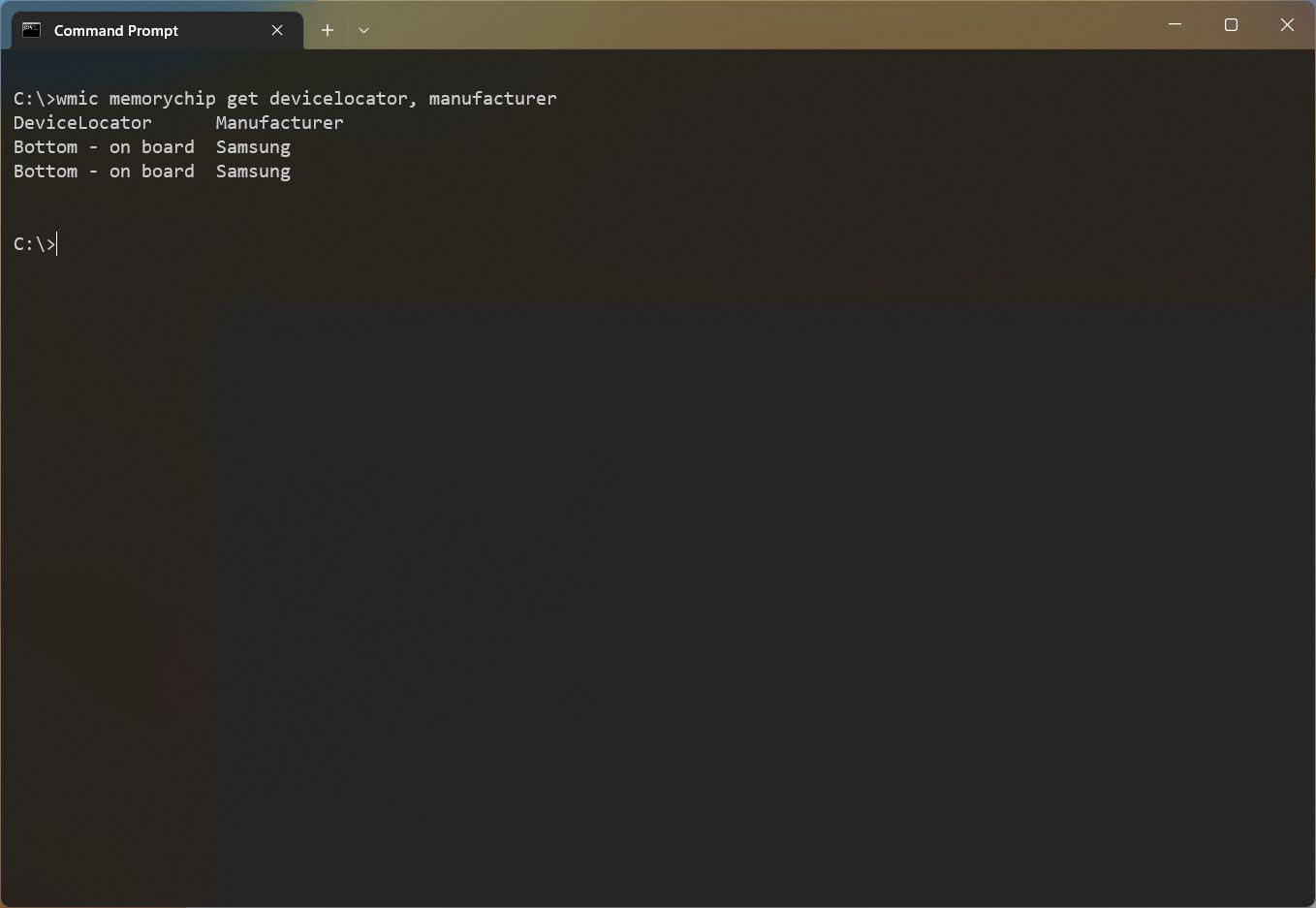
- Confirm the memory manufacturer name under the «Manufacturer» column.
Check part number
To determine the part number for each of the memory modules, use these steps:
- Open Start.
- Search for Command Prompt, right-click the top result, and select the Run as administrator option.
- Type the following command to determine the memory part number and press Enter: wmic memorychip get devicelocator, partnumber
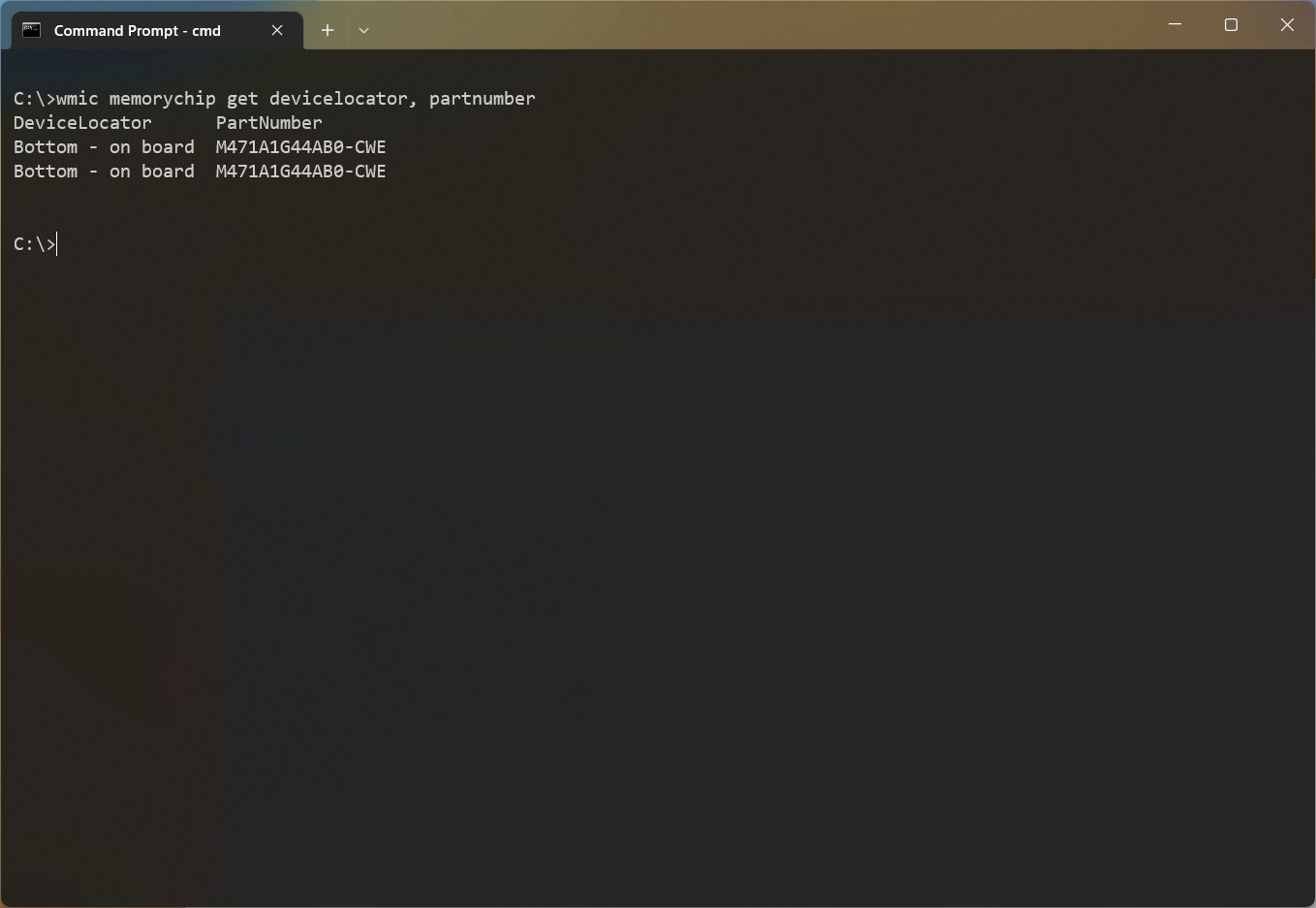
- Confirm the product number under the «PartNumber» column.
Check serial number
To check the memory serial number, use these steps:
- Open Start.
- Search for Command Prompt, right-click the top result, and select the Run as administrator option.
- Type the following command to get the RAM stick’s serial number and press Enter: wmic memorychip get devicelocator, serialnumber
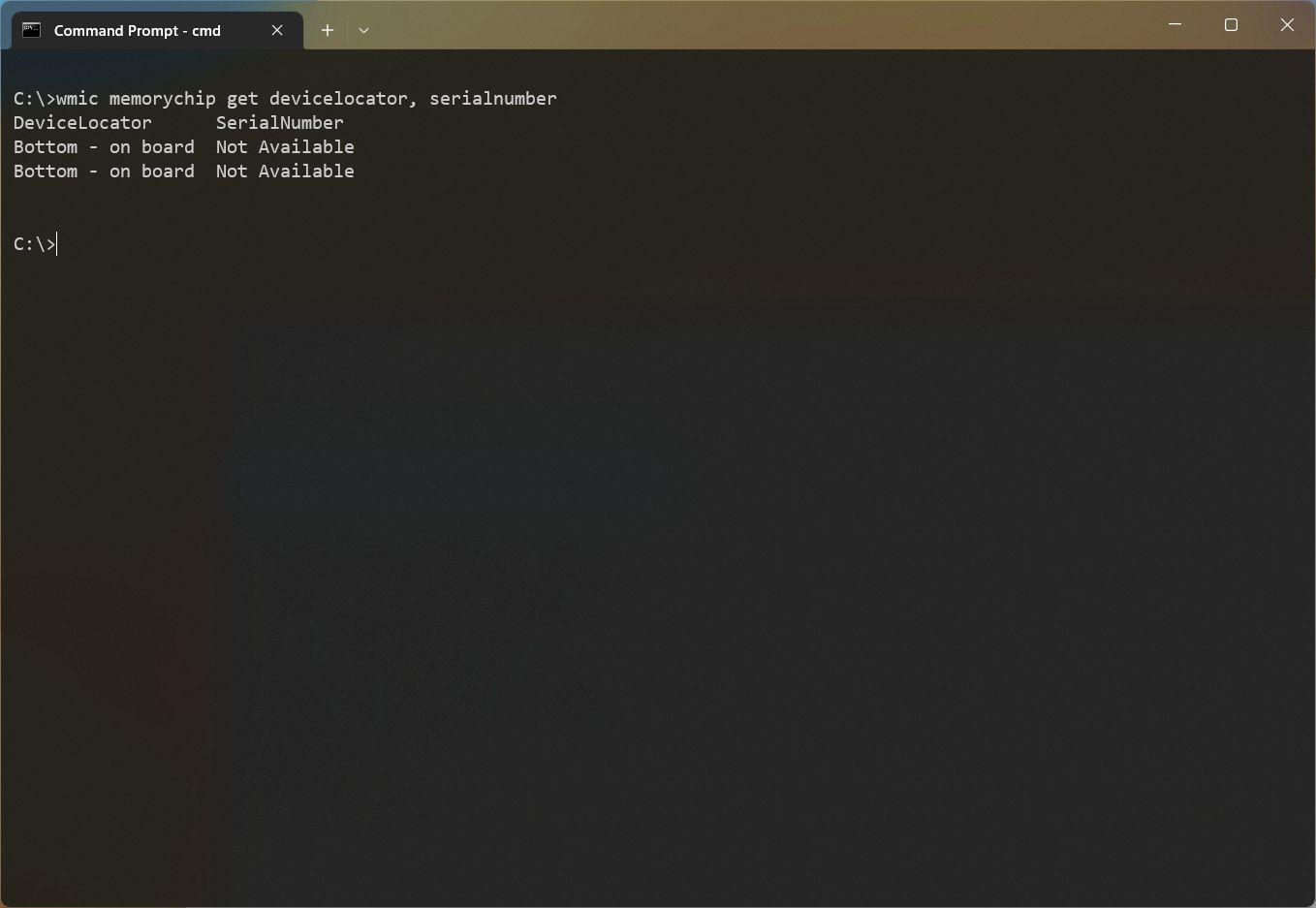
- Confirm the product serial number under the «SerialNumber» column.
- (Optional) Type the following command to find out the physical location of the stick on the motherboard and press Enter: wmic memorychip get banklabel, serialnumber
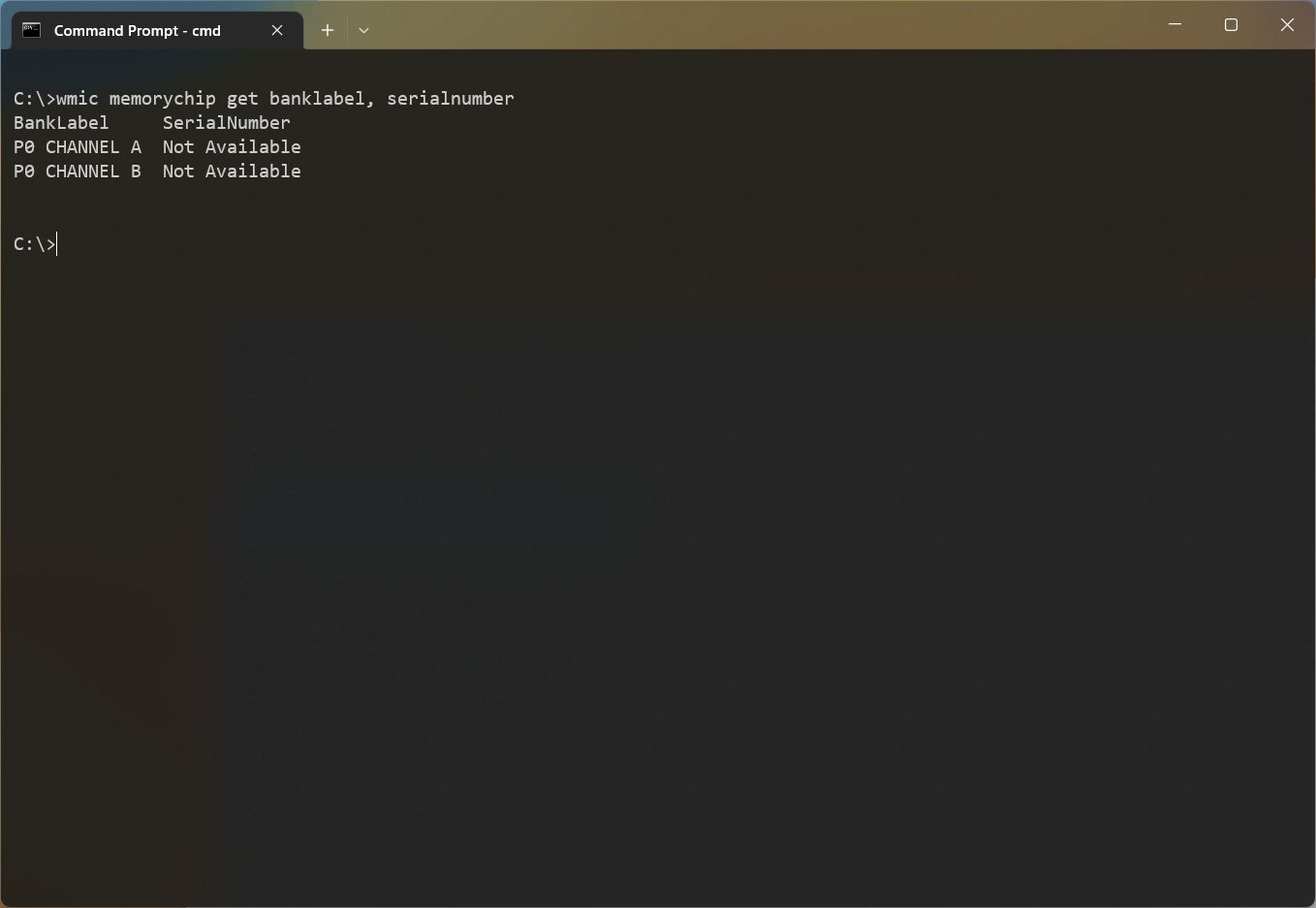
Check capacity
On Windows 11, you can also use different commands to determine the total system capacity or capacity per module.
Determine capacity per module
To find out the amount of memory available in each stick, use these steps:
- Open Start.
- Search for Command Prompt, right-click the top result, and select the Run as administrator option.
- Type the following command to determine each module capacity and press Enter: wmic memorychip get devicelocator, capacity
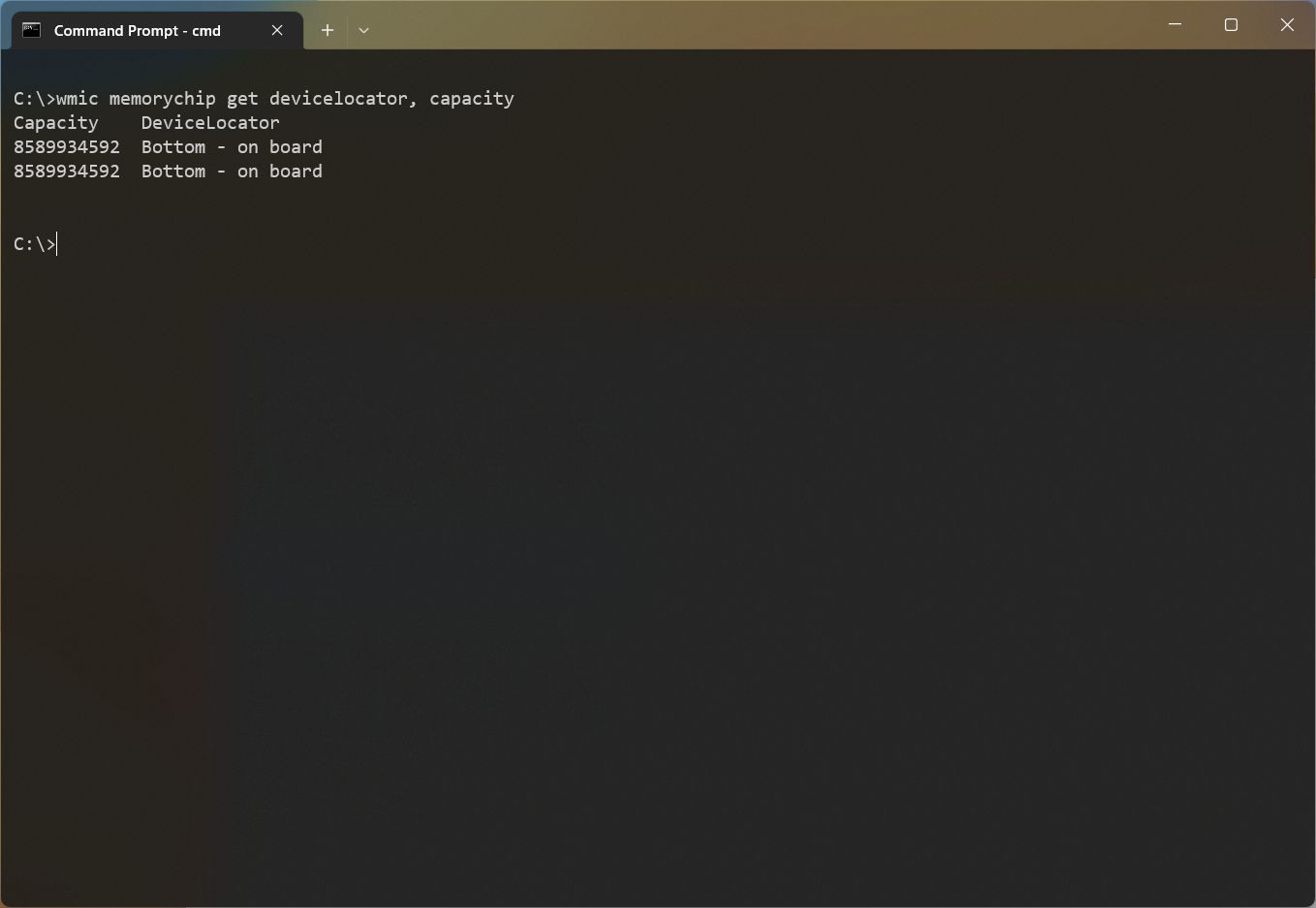
- Confirm the amount of RAM per module under the «Capacity» column.
Since the capacity is returned in bytes, you have to divide the number by 1,073,741,824 (1 gigabyte in bytes) to convert the information into gigabytes.
Determine capacity total
To determine the total amount of RAM installed on Windows 11, use these steps:
- Open Start.
- Search for Command Prompt, right-click the top result, and select the Run as administrator option.
- Type the following command to determine the total amount of RAM installed on the computer and press Enter: wmic computersystem get totalphysicalmemory
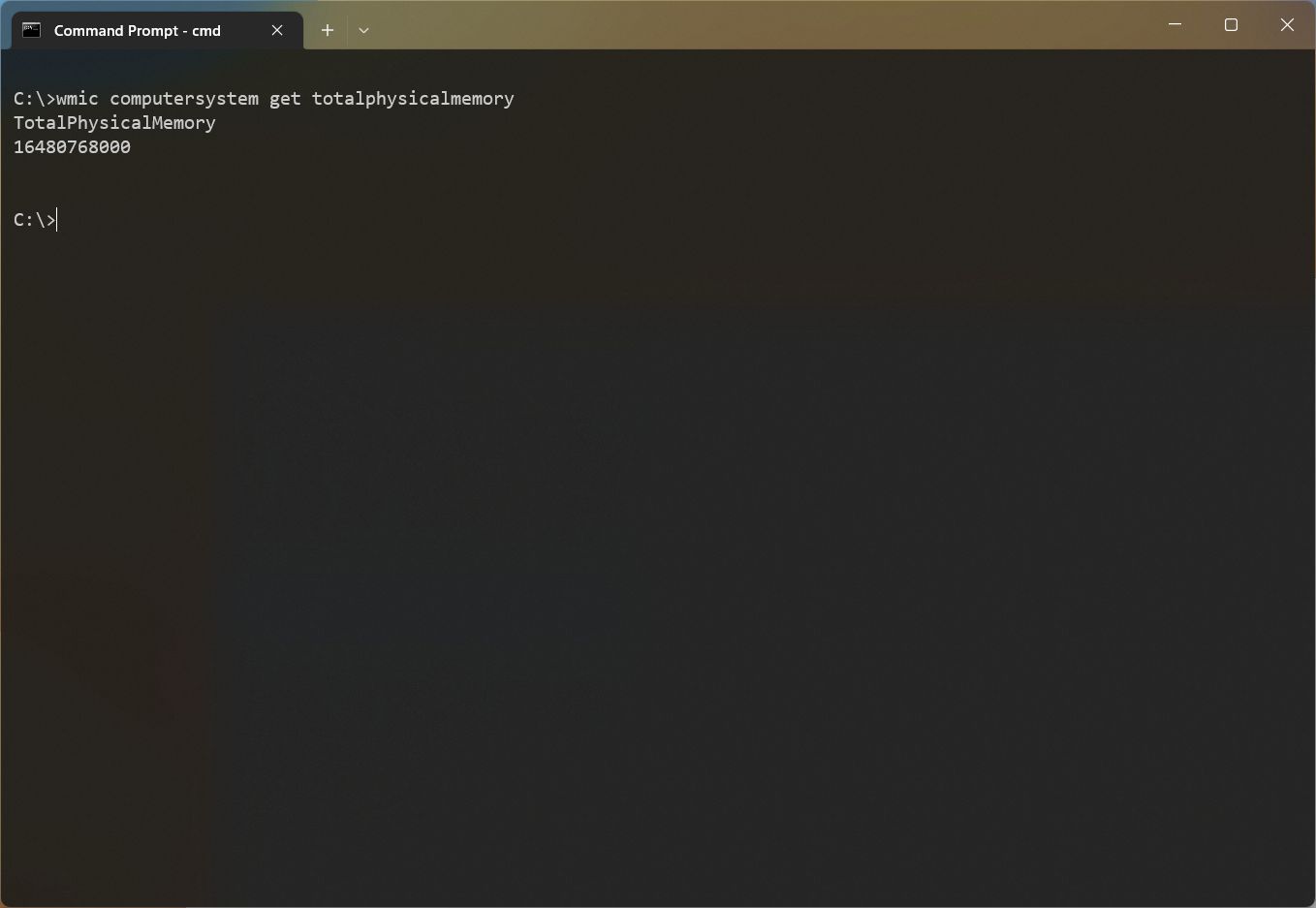
- Confirm the amount of RAM per module under the «Capacity» column.
To convert the information to gigabytes, you must divide the number by 1,073,741,824 (1 gigabyte in bytes).
Check speed
To find out the speed of the memory modules, use these steps:
- Open Start.
- Search for Command Prompt, right-click the top result, and select the Run as administrator option.
- Type the following command to check the memory speed and press Enter: wmic memorychip get devicelocator, speed

- Confirm each of the memory module’s speed under the «Speed» column.
Check type
To determine memory type (such as DRAM, DDR4, RDRAM, etc.), use these steps:
- Open Start.
- Search for Command Prompt, right-click the top result, and select the Run as administrator option.
- Type the following command to check the memory type and press Enter: wmic memorychip get devicelocator, memorytype

- Confirm memory type under the «MemoryType» column.
Supported memory types
Here’s the list of the memory types that the command can detect:
- 0: Unknown.
- 1: Other.
- 2: DRAM.
- 3: Synchronous DRAM.
- 4: Cache DRAM.
- 5: EDO.
- 6: EDRAM.
- 7: VRAM.
- 8: SRAM.
- 9: RAM.
- 10: ROM.
- 11: Flash.
- 12: EEPROM.
- 13: FEPROM.
- 14: EPROM.
- 15: CDRAM.
- 16: 3DRAM.
- 17: SDRAM.
- 18: SGRAM.
- 19: RDRAM.
- 20: DDR.
- 21: DDR2.
- 22: DDR2 FB-DIMM.
- 24: DDR3.
- 25: FBD2.
- 26: DRR4.
Check form factor
To determine the memory sticks form factor (such as DIMM, SODIMM, etc.) on Windows 11, use these steps:
- Open Start.
- Search for Command Prompt, right-click the top result, and select the Run as administrator option.
- Type the following command to check the memory form factor and press Enter: wmic memorychip get devicelocator, formfactor
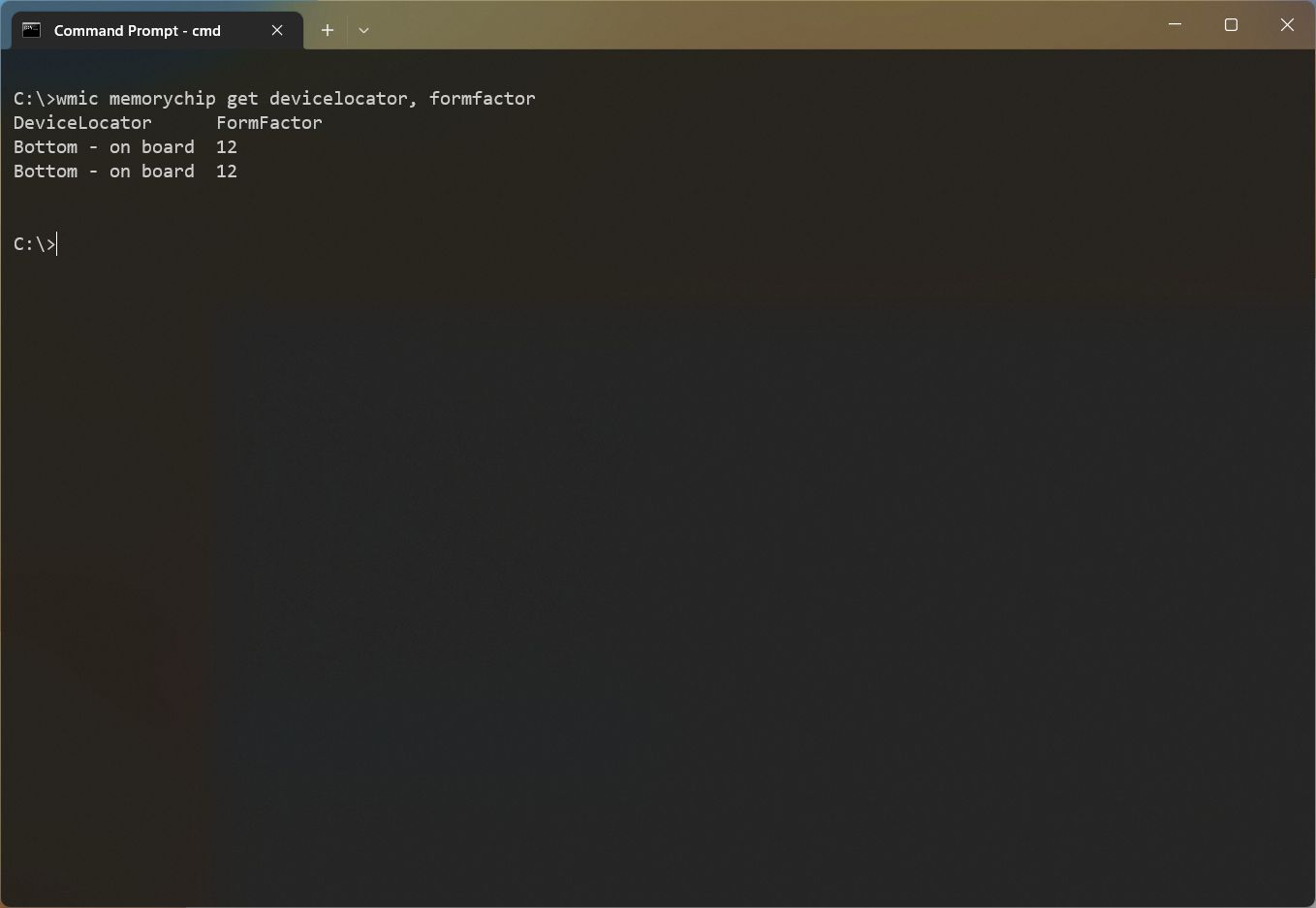
- Confirm the memory form factor under the «FormFactor» column.
If the output is 8, the computer uses DIMM modules (usually available on desktops). Otherwise, if the command output the number 12, the device uses SODIMM modules (commonly used on laptops).
Supported form factor
Here’s a list of the form factors that the command can detect:
- 0: Unknown.
- 1: Other.
- 2: SIP.
- 3: DIP.
- 4: ZIP.
- 5: SOJ
- 6: Proprietary.
- 7: SIMM.
- 8: DIMM.
- 9: TSOP.
- 10: PGA.
- 11: RIMM.
- 12: SODIMM.
- 13: SRIMM.
- 14: SMD.
- 15: SSMP.
- 16: QFP.
- 17: TQFP.
- 18: SOIC.
- 19: LCC.
- 20: PLCC.
- 21: BGA.
- 22: FPBGA.
- 23: LGA.
- 24: FB-DIMM.
Check full specs
You can use the previous command to find specific information about the memory modules individually. However, you can also query all the memory specs with a single command on Windows 11.
To view all the memory details, then use these steps:
- Open Start.
- Type Command Prompt, right-click the top result, and select the Run as administrator option.
- Type the following command to view all the memory details and press Enter: wmic memorychip list full
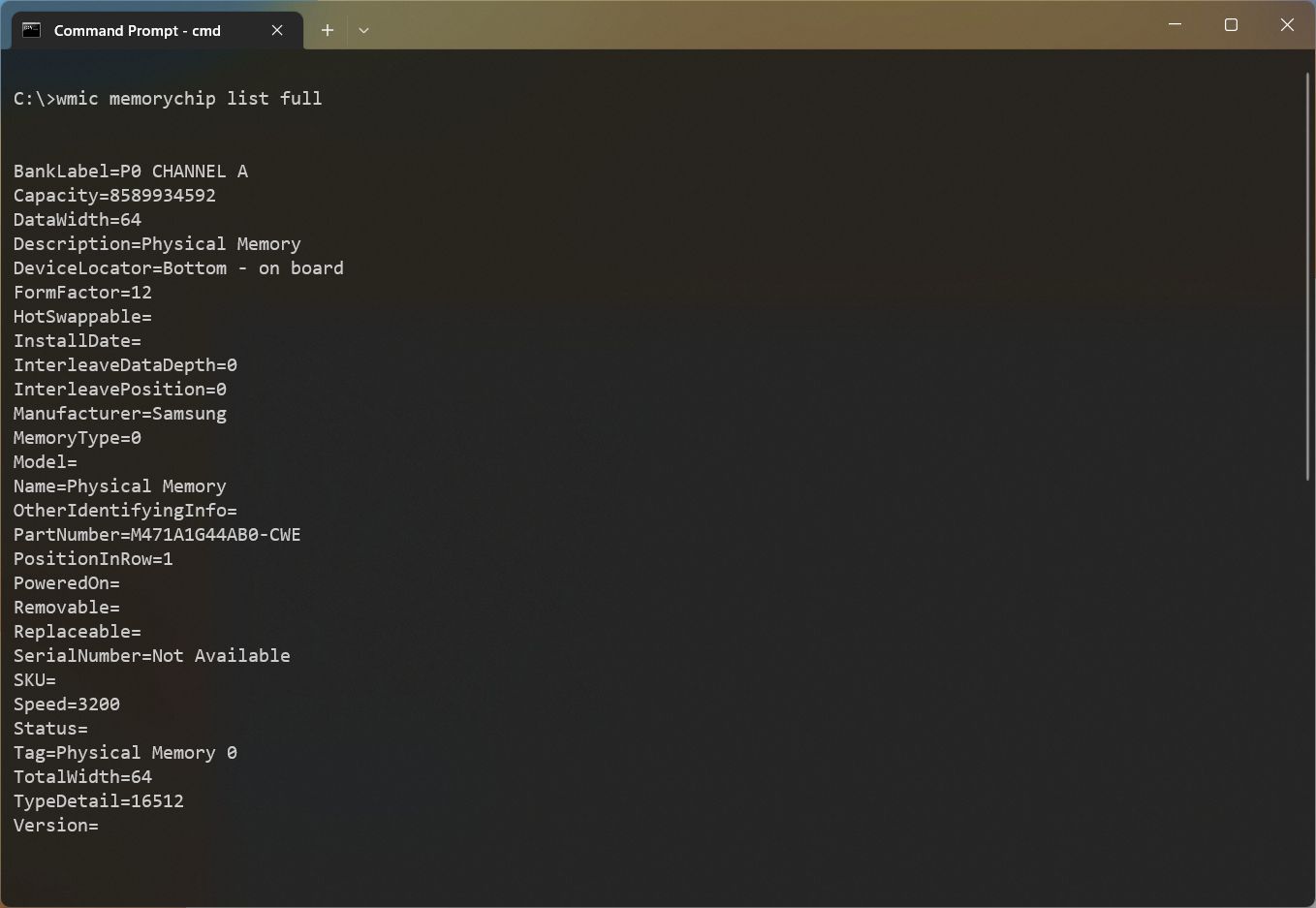
- Confirm the specs for each module installed on the device.
- (Optional) Type the following command to view only the specific details and press Enter: wmic memorychip get devicelocator, manufacturer, partnumber, serialnumber, capacity, speed, memorytype, formfactor
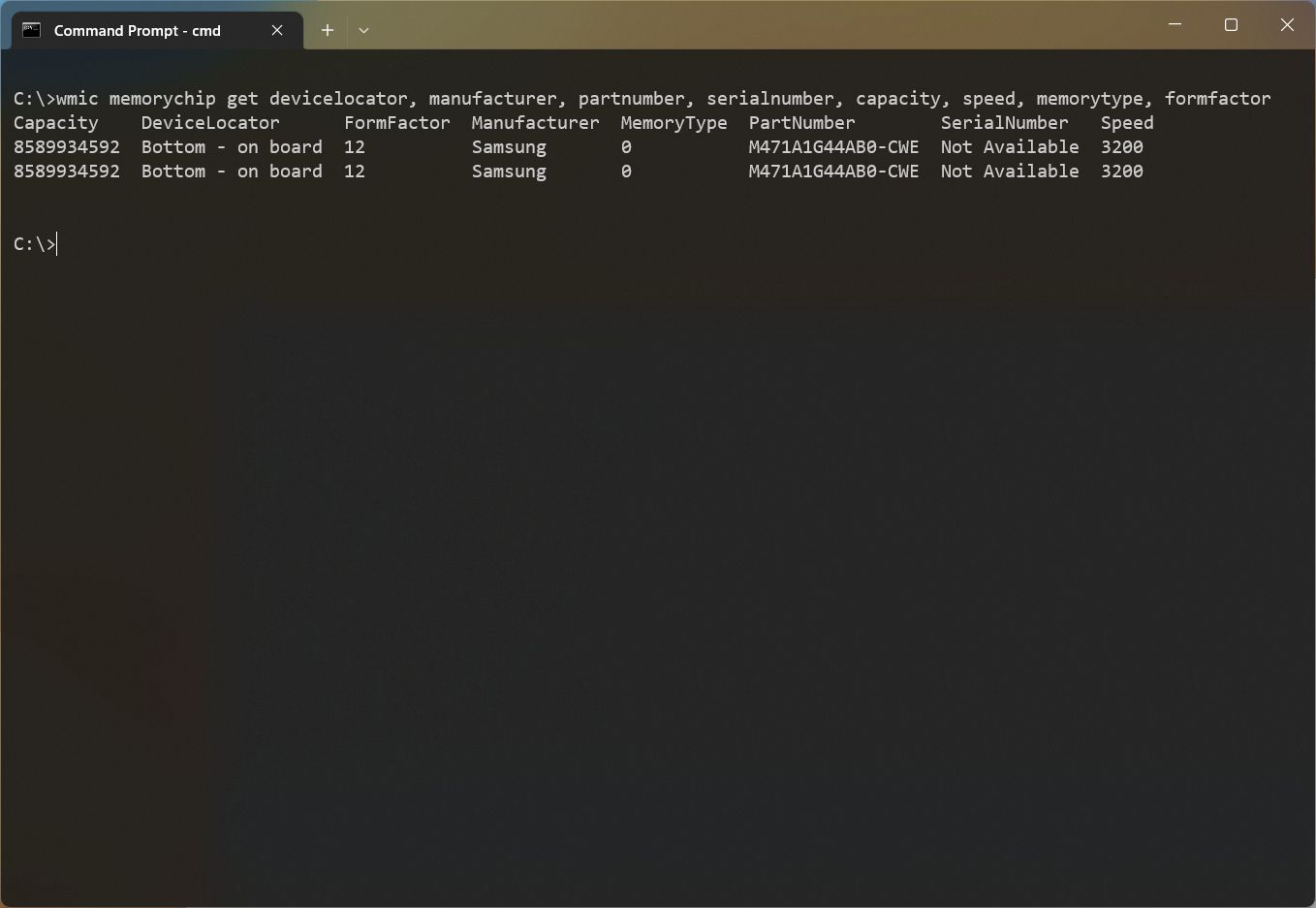
- Confirm the memory details.
Once you complete the steps, you will have a full overview of the memory specifications.
More resources
For more helpful articles, coverage, and answers to common questions about Windows 10 and Windows 11, visit the following resources:
- Windows 11 on Windows Central — All you need to know
- Windows 10 on Windows Central — All you need to know
Mauro Huculak has been a Windows How-To Expert contributor for WindowsCentral.com for nearly a decade and has over 15 years of experience writing comprehensive guides. He also has an IT background and has achieved different professional certifications from Microsoft, Cisco, VMware, and CompTIA. He has been recognized as a Microsoft MVP for many years.
-
Home
-
News
- How to Check RAM on Windows 11/10 (Size, Speed, Type, etc.)
By Vera | Follow |
Last Updated
Do you want to know the details of the RAM on your computer? It is very easy to check RAM on Windows 11/10. Today in this post, MiniTool Solution will show you how to check RAM speed, size, type, and other information in multiple ways.
RAM, random-access memory, is a form of computer memory installed on the motherboard of a computer. It is used to store temporary information from Windows and other applications. When turning off the computer, any data in RAM is lost.
In some cases, you need to know the information of your RAM installed on your computer. For example, you need to know how much the RAM size is when installing or upgrading the Windows operating system, or installing a high graphics game; when your system slows down and you perform a diagnosis, knowing the RAM used by a particular application is important; if you want to upgrade RAM, it is also important to check Windows RAM.
How can you check RAM on Windows 11 if you have upgraded to this new operating system? In the following part, let’s see some methods.
How to Check RAM in Windows 11/10
Check RAM Windows 10/11 via Settings
Step 1: Click the Start icon and choose Settings to open this app.
Step 2: Choose System from the sidebar, scroll down to find About, and click it.
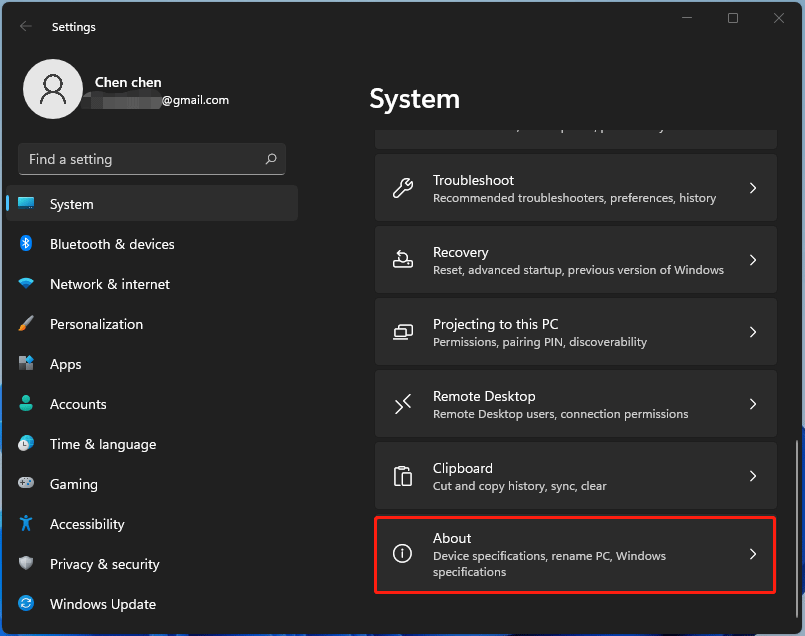
Step 3: You can find the RAM information – RAM size under the Device specifications section.
Check Windows 11 RAM via System Information
Step 1: Press Win + R to open the Run dialog, type msinfo32, and click OK.
Step 2: In the System Information window, go to the right section and you can find some details of RAM: Installed Physical Memory (RAM), Total Physical Memory, Available Physical Memory, Total Virtual Memory, and Available Virtual Memory.
Check RAM via Task Manager
You may ask: how to check RAM speed in Windows 10/11? To know the real-time statistic of RAM usage by your system including RAM speed, you can open Task Manager.
Step 1: Run Task Manager in Windows 11 or 10.
Step 2: go to the Performance tab and click Memory from the sidebar.
Step 3: On the upper right section of the screen, you can see the total RAM size and the RAM type. In the lower right part of the window, you know the used RAM size, available RAM size, RAM speed, memory model form factor, and more.
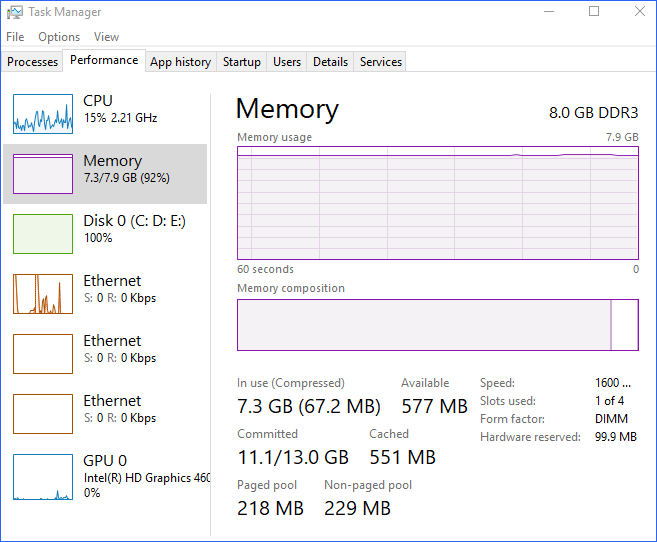
Check Windows 11 RAM via Command Prompt
To know more information about your RAM on the Windows 11/10 computer, you can resort to Command Prompt.
- Just follow one of these ways to open CMD – How to Open Command Prompt (CMD) in Windows 11? (7 Ways) and then start the check task.
- Type wmic memorychip get/format:list and press Enter to check all the specifications of RAM.
Some useful commands:
- Check the total physical memory installed on your computer – systeminfo | findstr /C:”Total Physical Memory”
- Check memory speed – wmic memorychip get devicelocator, speed
- Check memory type – wmic memorychip get devicelocator, memorytype
A numerical value will return after typing the memory type command and the meaning of the value is: 21 – DDR2, 22 – DDR2 FB-DIMM, 24 – DDR3, etc. We only list some common values and you can search for the meaning online based on the value you get.
Final Words
How to check RAM on Windows 11/10? After reading this post, you can find some useful methods to easily check your RAM speed, type, size, and more. Just choose one based on your actual situation.
About The Author
Position: Columnist
Vera is an editor of the MiniTool Team since 2016 who has more than 7 years’ writing experiences in the field of technical articles. Her articles mainly focus on disk & partition management, PC data recovery, video conversion, as well as PC backup & restore, helping users to solve some errors and issues when using their computers. In her spare times, she likes shopping, playing games and reading some articles.
Windows 11 RAM Type: Guide to Boosting Performance
Dive into the essentials of identifying your Windows 11 RAM type with our comprehensive guide, designed to elevate your computing experience to new heights. Whether you’re planning to upgrade your system, troubleshoot performance issues, or simply satisfy your curiosity, understanding the specifics of your RAM is crucial. From navigating the Settings app to delving into the depths of Task Manager, Command Prompt, and PowerShell, we cover all bases to ensure you’re well-equipped. Plus, for those intrigued by the fusion of technology and finance, learn more about sport betting with cryptocurrency, a realm where cutting-edge meets entertainment. Join us on this journey to unlock the full potential of your Windows 11 system, seamlessly blending tech savvy with insightful exploration.
Windows 11 RAM Type: An Overview
Understanding your computer’s RAM (Random Access Memory) type is pivotal in optimizing its performance, especially when upgrading or troubleshooting. With Windows 11, recognizing your RAM type not only helps in ensuring compatibility with your system but also in maximizing the efficiency of your device. This guide elucidates simple yet effective methods to ascertain your Windows 11 RAM type, ensuring a seamless and informed computing experience.
RAM Specifications in Windows 11 Settings
The Windows 11 Settings app provides a straightforward pathway to discover your system’s total memory capacity. This section walks you through the process, detailing each step for your convenience.
Accessing the Settings App
- Press
Win + Ito open the Settings app. - Navigate to
Systemand then selectAbout. - Here, under the “Device specifications” section, you’ll find details about your installed RAM.
This method offers a quick glimpse into your system’s memory capacity but falls short of providing detailed RAM type information.
RAM Information in Settings
In the Settings app, the information displayed includes the total installed RAM. However, for insights into RAM type, such as DDR4 or DDR3, and other specific attributes, additional steps are necessary, as detailed in the subsequent sections.
Task Manager for RAM Type
The Task Manager in Windows 11 is a powerful tool that goes beyond mere memory capacity, offering detailed insights into your RAM type and performance.
Task Manager Access
Right-click the Start button and select “Task Manager,” or press Ctrl + Shift + Esc. If the Task Manager opens in the compact mode, click on “More details” to expand it.
RAM Information in Task Manager
- Navigate to the
Performancetab and selectMemory. - Here, you’ll see your RAM’s speed, form factor, and used slots versus total slots.
- To identify RAM type (e.g., DDR4), observe the speed and compare it with standard RAM types, as Task Manager might not explicitly list the DDR version.
Command Prompt for Detailed RAM Specs
For those seeking comprehensive RAM specifications, the Command Prompt is an invaluable resource.
Command Execution
- Press Win + R, type cmd, and press Enter to open Command Prompt.
- Input
wmic memorychip get banklabel, capacity, speed, memorytypeand press Enter.
This command fetches detailed specifications, including the memory type, though it presents the RAM type in numerical form.
Command Output
The output displays various attributes, such as bank label and capacity. The memorytype field shows a numerical code representing the RAM type, which you can decode using online references to determine whether it’s DDR3, DDR4, etc.
PowerShell for RAM Type Identification
PowerShell offers another approach to unveiling detailed RAM specifications, including the exact RAM type.
PowerShell Command Execution
Right-click the Start button and select “Windows PowerShell”.
- Enter
Get-WmiObject -Class Win32_PhysicalMemory | Select-Object Speed,Manufacturer,PartNumber,DeviceLocator,MemoryTypeand press Enter.
This command provides a wealth of information about your RAM, including speed and manufacturer.
PowerShell Output
The MemoryType in PowerShell’s output also uses numerical codes akin to those in Command Prompt. Alongside, you’ll receive data on speed, manufacturer, and part numbers, assisting in a comprehensive understanding of your RAM’s specifications.
Summary
Identifying your Windows 11 RAM type is crucial for system upgrades and performance optimization. This article has navigated through several methods, including the Settings app, Task Manager, Command Prompt, and PowerShell, each offering varying levels of detail about your RAM specifications.

